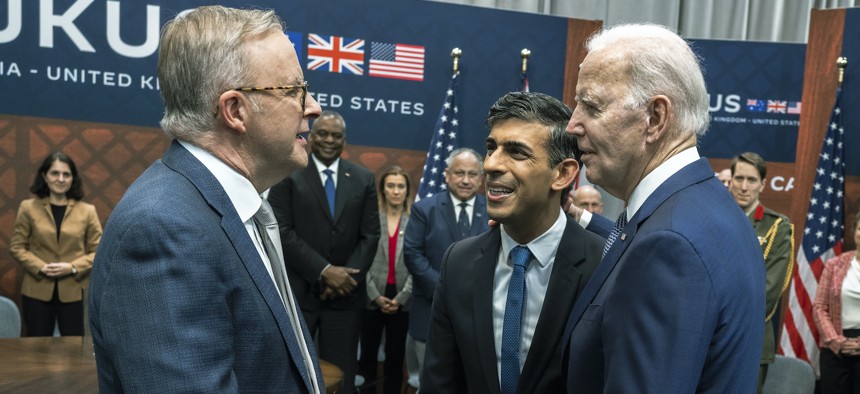
President Joe Biden greets British Prime Minister Rishi Sunak and Australian Prime Minister Anthony Albanese the AUKUS bilateral meeting in San Diego, Calif, March 13, 2023. Defense Department / Chad J. McNeeley
US Open to Expanding AUKUS
New participants to the partnership between Australia, the United Kingdom and the United States would need to provide beneficial tech contributions, officials said.
The United States is open to allowing more countries to participate in the technological side of the monumental Australia-United Kingdom-U.S. agreement known as AUKUS, but they would have to show they can contribute in meaningful ways, officials said Monday.
“We are in conversation with a variety of countries who are interested. And frankly, it goes far beyond just those countries, and we're grateful for that. The fact that countries are interested in it is a positive, and we will explore those appropriately,” Kurt Campbell, the deputy assistant to the president and coordinator for the Indo-Pacific, said during an event Monday at the Center for Strategic and International Studies.
“I think all three countries have made clear that under the appropriate circumstances we would be prepared to work collaboratively with other partners who bring capacity to the challenge.”
The AUKUS agreement was established in September 2021 and is made up of two “pillars”: the first is providing Australia nuclear-powered attack submarines, and the second involves key technologies such as hypersonics, underwater drones, and artificial intelligence, as well as “functional” areas like information sharing, according to a Congressional Research Service report.
New Zealand, South Korea, and France have expressed interest in the second pillar, said Charles Edel, the CSIS Australia chair. The White House in April 2022 said that as their work matures “within these and other critical defense and security capabilities, we will seek to engage allies and partners as appropriate.”
Chief of Naval Operations Adm. Mike Gilday said “there’s huge potential” in having more countries participate, with the caveat that it be in “selected areas.”
Instead of a broad invitation to join, “I would look at certain areas where nations bring technology to bear that is going to make a difference, and that we have high trust and confidence that we can share that information back and forth,” Gilday said.
Campbell added that the U.S. would want real contributions from those who join.
“I think the key is going to be…what do you bring to the table? And are you able to do it in such a way that's going to be practical and operational?,” he said. “So we're not just looking for theoretical applications and partnerships, but practical, real efforts that will enhance defense capabilities.”
Pillar two also allows the partnership to leverage the research and development already being done by private industry to deliver new technology even faster, Gilday said.
“So we're trying to use, in some ways, pillar two to accelerate that significantly, so we can take disruptive technologies …and to get them on the table,” he said.


